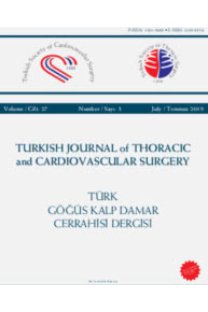Extracorporeal membrane oxygenation for cardiogenic shock after cardiac surgery: predictors of early mortality and outcome from 21 patients
Extracorporeal membrane oxygenation for cardiogenic shock after cardiac surgery: predictors of early mortality and outcome from 21 patients
___
- ISSN: 1301-5680
- Yayın Aralığı: 4
- Başlangıç: 1991
- Yayıncı: Bayçınar Tıbbi Yayıncılık
Ekspoze olmuş kalp pillerinin cep değişikliği ve lokal flep yardımı ile kurtarılması
Ufuk ÇİLOĞLU, N Sinem ÇİLOĞLU, Nesrin GÜMÜŞ, Teoman ERASLAN
Splenik arter anevrizmalarında endovasküler yöntemler
Veysel TEMİZKAN, Gökhan İNANGİL, Alper UÇAK
Torakal yaklaşım ile akciğer, karaciğer ve dalak kist hidatiklerinin cerrahi tedavisi
Erkmen GÜLHAN, Sadi KAYA, Koray AYDOĞDU, Leyla Nesrin ÜSTÜN, Funda İNCEKARA, Nurettin KARAOĞLANOĞLU, Ülkü YAZICI, Göktürk FINDIK
Kombine aort kapak replasmanı ve canlı vericili karaciğer nakli
İlhan SANİSOĞLU, Murat DAYANGAÇ, Zehra BAYRAMOĞLU, Mehmet Kerem ORAL, Levent ÖKLÜ, Füsun YENER, Yaman TOKAT
Pulmoner arterin kist hidatiği
Kenan Can CEYLAN, Ozan USLUER, Hakan POLAT, Hüdaver ALPER, Özgür SAMANCILAR, Şeyda ÖRS KAYA, Deniz AKPINAR
Intrapericardial teratoma excision in a preterm infant following in-utero pericardiocentesis
Adnan UYSALEL, Acar KOÇ, Ercan TUTAR, Fikri DEMİR, Zeynep EYİLETEN, Anar ALİYEV, Semra ATALAY
E YILMAZ, G UGUR, H YALİNİZ, V KEKLİK, M S TOPCUOGLU, SO KEMAL, A ATAKAN, Y BASTURK, D SABA, M B RABUŞ, A FEDAKAR, M BALKANAY, B YUKSEL, K VECİH
Preemptif pregabalinin torakotomi sonrası ağrı ve epidural analjezi üzerine etkisi
Hilal SAZAK, Mehtap TUNÇ, Demet ÇINAR, Serdal Kenan KÖSE, Şaziye ŞAHİN
Ekstrakorporeal sirkülasyon ile trakeal stent uygulanması
Bilge ÇELEBİOĞLU, Seda Banu AKINCI, Alev ŞAYLAN, Banu AYHAN, Ülkü AYPAR, Meral KANBAK, İsmail Aydın ERDEN
